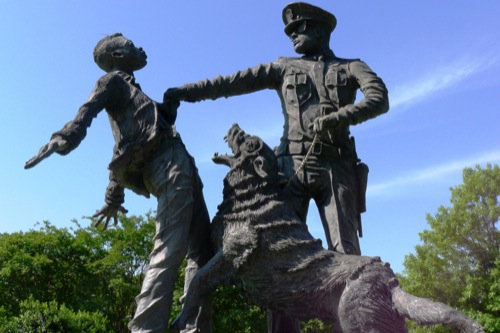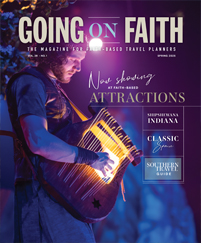
Courtesy Greater Birmingham CVB
Birmingham
[ Alabama ]
Commemorating the 50-year anniversary of the civil rights movement in 2013, Birmingham is hosting a number of special events, including a commemorative march, symposiums, art shows and the opening of a historic civil rights trail. The trail follows the paths of the frequent nonviolent protests throughout the city. Along the way, interpretive signs, graphics and pictures help bring historical context to the places.
“All of the main attractions will take part in some way,” said Vickie Ashford, director of travel media at the Greater Birmingham Convention and Visitors Bureau. “Events will be in the historic district, but also in the local theaters, libraries and performing-arts centers.”
During the movement, the six-block area now known as the Civil Rights Historic District was a center of conflict, protest and violence. Visitors may recognize the area from the horrifying images of black protesters being attacked by dogs and sprayed by high-pressure hoses that became famous during the civil rights movement. Groups can see the 16th Street Baptist Church, which was famously bombed by a racist group, along with nearby Bethel Baptist Church, which is credited with shaping the civil rights movement in the city.
The Birmingham Civil Rights Institute shows visitors the injustices African Americans suffered from the late 1800s to the 1960s. The museum’s introductory film opens with a poignant scene showing images of public drinking fountains labeled “colored” and “white.” Visitors can also see the uplifting footage of Martin Luther King Jr.’s “I Have a Dream” speech and the jail cell where King wrote “Letter From the Birmingham Jail.” A display on Birmingham’s first black mayor, Richard Arrington, shows how far the city has come.
Kansas City
[ Missouri ]
There was no more exciting place to be in Kansas City in the 1920s than the 18th and Vine District. Today, the area is reclaiming some of its former glory with the Negro Leagues Baseball Museum and the American Jazz Museum.
The Negro National League was founded not far from the district in 1920 as a showcase for black baseball players. Groups can take guided tours of the museum or guide themselves through the galleries of artifacts, pictures, and game footage that helps the diamond experience come alive. Exhibits tell what life was like on and off the field for players in the years before baseball integrated.
The Field of Legends features life-size bronze statues of 12 famous Negro Leagues players, 11 of whom are also immortalized in the Baseball Hall of Fame in Cooperstown. Famous names include “Buck” O’Neil, “Satchel” Paige and Josh Gibson, one of the greatest sluggers of all time.
Next door, the Kansas City Jazz Museum carries on the rich jazz heritage of Kansas City that has been part of the 18th and Vine area since the 1920s. The museum houses exhibitions on jazz greats such as Count Basie and Charlie Parker, who both played in the area in its heyday. Along with photos, instruments and plenty of music recordings, the museum hosts local jazz performers in the intimate Blue Room theater.
www.visitkc.com
Harlem Tours
[ New York City ]
It’s difficult to talk about African American heritage without mentioning Harlem. As the epicenter of African-American culture at the start of the 20th century, Harlem had its first renaissance as African Americans based in the southern United States saw an opportunity in New York City after a market crash.
“The real-estate market was overbuilt, and the landowners were unable to sell the homes, so African Americans had the opportunity to settle in Harlem and rent the apartments,” said Erika Elisabeth, vice president of New York Visions Travel Group, which runs Harlem Spirituals Gospel and Jazz Tours. “The explosion of literature, music, and culture that grew out of that makes the area special.”
Jazz brought African-American culture into the American mainstream as legendary artists like Lena Horne and Cab Calloway brought the style to a wider audience at the Cotton Club. Famous families like the Rockefellers would go uptown to enjoy music, and today the Cotton Club offers big-band music just like it did in the 1920s. The Apollo Theater offers a variety of entertainment options for groups, including comedy, dance and music.
Worshippers from all over the world travel to Harlem to experience faith in vibrant churches like the Mother African Methodist Episcopal Zion Church, the Abyssinian Baptist Church and the Greater Highway Deliverance Temple. Harlem Spirituals even offers choir workshops with local gospel choirs and the opportunity to sing in a choir exchange.










